Introducing the BLAVOR Solar Charger Power Bank, the perfect companion for anyone who loves outdoor adventures or needs reliable charging on the go. This power bank is made by BLAVOR, a well-established brand with over 27 million users worldwide and a decade of experience in portable solar power banks. With its foldable solar panels, this device ensures you have a reliable source of energy wherever you go.
The BLAVOR Solar Charger Power Bank is made of high-quality materials that guarantee durability, safety, and reliability.






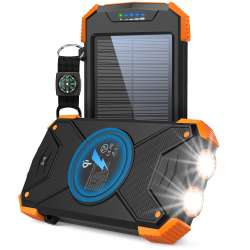
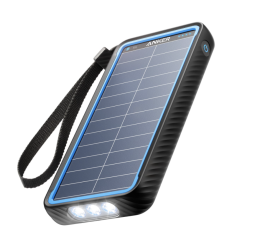
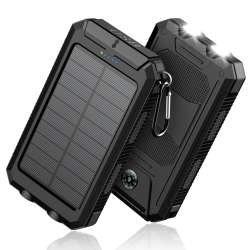
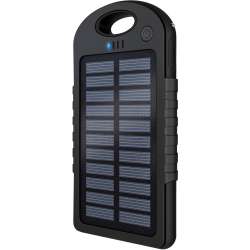

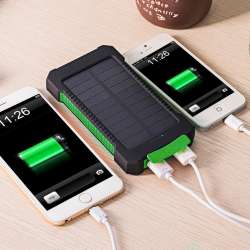
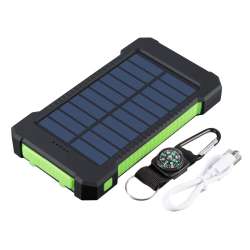
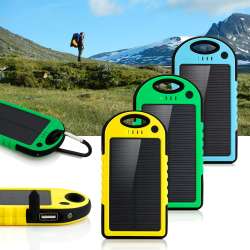
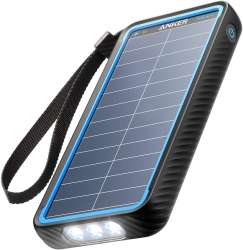












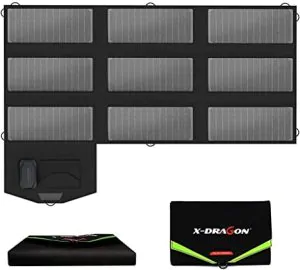
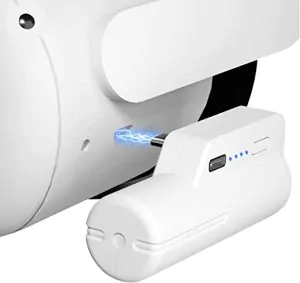
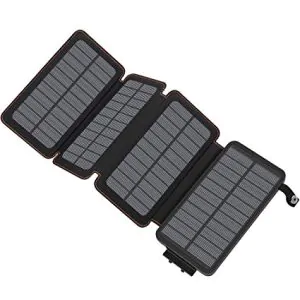
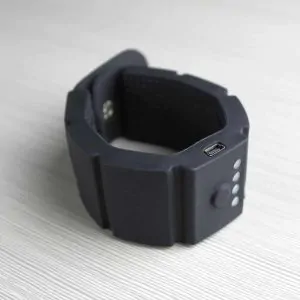
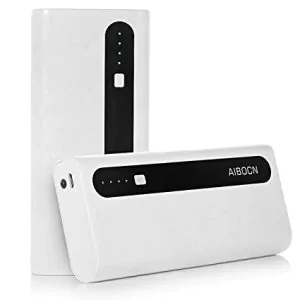
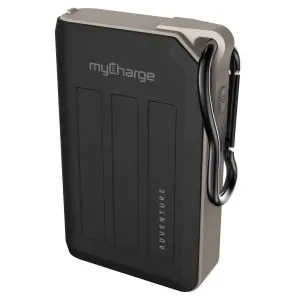
David L –
This is a convenient power pack that tries to build everything in one. USB power, compass, a camping light, and a mini flash/strobe light. It is rugged and the attached solar panels can be easily folded up and secured with a button. Unlike many cheaper solar power packs out there, this one actually supports USB-C Power Delivery up to 18W.Here’s my take on this item:Design: I think this item is well designed and they have made pretty good use of the space available to make sure the item is not too bulky yet ruggedized to handle bumps while you are on the road. The ports are nicely tucked inside a rubber cover so you don’t have to worry about the ports getting wet when it is on your backpack and it is raining outside (it comes with a carabiner clip with a keychain ring to attach to both the unit and your backpack – see picture).Ports – On the USB ports, they support a wide range of different charging protocols: Apple 5V/2.4A, Samsung 5V/2A, BC DCP 5V/1.5A, QC2 5/9/12V, QC3, FCP, MTKPE 1.1 PE2.0. Although one of the ports is labeled blue, the black one also supports QC2/3 (there is no difference between the ports). That said, only one port can be used at any given time for quick charge based protocols to engage, otherwise, both ports would be available at 5v only (most likely because they share the charging circuitry on the USB ports).The bidirectional USB-C port supports PD3.0 5V/9V/12V PDOs at 2.4A/2.0A/1.5A, respectively. Also, it supports Apple/2.4A and BC DCP 5V/1.5A. This is nice because most battery packs around this range would only support a dummy USB-C port that operates at 5v only and would not allow Google Nexus devices to charge beyond 5v. Having PD fixes that issue.Note that since the ports are tucked inside the rubber cover, there isn’t a lot of clearance for direct plug-in USB devices that are wide-sized. In those cases, you may need some kind of USB extension or right-angle adapter for the plug to fit properly. Most devices, however, use a standard USB cable to connect so this shouldn’t be an issue for most devices (you can see that I have to plug a tester on top of another tester because that second tester was a bit too wide to fit into the mouth of the rubber casing).Charging – Charging is fairly straightforward. You have the option of using either the Micro-USB port or the USB-C port. When using the Micro-USB port, you are limited to 5v/2.4A unless your chargers support the Huawei FCP 9v protocol (although many times the battery pack ends up charging at around 2.7A or so if your charger has good voltage regulation and the voltage remains high). Most chargers that are made in China to support QC2 generally also support FCP, although pure QC2/3 chargers will not trigger 9v charging. This is the same when using the USB-C port, although the battery pack would request PD @ 9v as well as FCP when it is available. When charging at 9v, the amperage is limited to 2A @ 18W.Maximum Discharging Current – Testing the maximum current at the various voltage levels offered by this battery pack without significant voltage losses, I got 5V/3A, 9V/2A, 12V/1.5A. This is pretty much within the stated specifications, except that I was able to exceed the 5V/2.4A rating slightly until the 3A mark.Load voltages – Under no load, the voltages were recorded as 5.08v/9.12v/12.11v. This is good since they were a little higher to allow for some cable resistance. As you can see, the battery pack was able to maintain a very stable voltage even at load (4.97v/3A, 8.92v/2.06A, 12.01v/1.51A).Flashlights – The flashlight in front does a pretty good job in illuminating the way in front of you, as you can see in the pictures I have attached with the dark kitchen. The small flashlight was directional, so it illuminates in the immediate vicinity in front of you, but not around you. The camping light, on the other hand, is much brighter and my first reaction when I turned that on was – wow! On high brightness, the kitchen looked as if I turned the lights on, whereas on low/medium brightness it’s only slightly dimmer than the high brightness (see pictures). This makes this a very good tool while working in a dark garage, or simply keeping in your car in case of an emergency.Auto on/off: The battery pack turns off after 30 seconds of low/no load (by reducing the output voltage to ~2v). This means you do not have to manually turn on the battery pack to start charging anything that you start plugging in since the device senses this and restores power at the appropriate level. This offers convenience, although at the trade-off of some standby power.USB passthrough charging: This battery pack supports true passthrough charging. If a 9v input is already engaged, it disengages and falls back to a 5v input source. The battery pack then passes the 5v input from the charger to its output ports while simultaneously charging itself. Because of the true pass-through function, the output voltage is no longer regulated by the battery pack, but rather than the voltage source (e.g. charger). For that reason, the output voltage can drop to around 4.5v when the battery pack is charging from the source at high currents. Adding device load while the battery pack is charging is additive to the input current, and if you have a very good charging cable (e.g. a 1ft USB-C to C 5A cable), the current can reach 5v/3A when the other device is plugged in (the enclosed USB-A to USB-C 2.0 cable charges at around 2.2A when I tested). The battery pack also seems to have a protection function that prevents the pass-thru voltage from getting too high due to a malfunction of the charger. In this case, it looks like the battery pack shuts off charging when the output port reaches approximately 5.45v (using a charger source of approximately 6.40v while charging at around 2.67A). This is a good mechanism to prevent your device from frying if the charger somehow malfunctions and continues to provide 9v QC even when the battery pack did not ask for it.Capacity Testing: The discharge test yielded a real capacity of approximately 65.04Wh (~88% efficiency) at 5v/2.3A. This is quite efficient given the high current. On the other hand, charging at 5v/2.7A required about 94.92Wh of energy (~78% efficiency) without any supplemental sunlight. I am assuming this is due to the converter being less efficient at higher currents, although I plan to be putting this in the back of my car to gather sun while it is out so charging efficiency isn’t a big problem to me.Solar Charging: The charger’s solar indicator (the green light that is next to the battery status indicator) is quite sensitive, and turns on even at the slightest of sunlight. However, it is important to note that the panels all together can only produce 1.2A of current under intense sunlight (theoretically 6W max). Assuming the panels produce 82% of the theoretical maximum, and another 80% of that energy is used to charge the battery, that means the panels are adding about 3.94W of power to the batteries under intense sunlight.Assuming the energy required is 25% above the nominal capacity value (92.5Wh), this means approximately 23.48 hours of intense sunlight is required to fully charge the battery from empty to full.If you were to leave the battery pack in a sunny place all day long without moving it (assuming ~5.5 hours of intense sunlight), this would mean it would take slightly more than 4 days to charge it under these conditions.If you are on the go and moving between shady and sunny areas, you may only be exposed to intense sunlight (or equivalents of) for about 1.5 hours or so. In this case, the time to fully charge a depleted pack increases from 4 days to a bit more than 2 weeks.And since cloudy days yield very little current (generally 5-10% of the power generated compared to the intense sunlight power), you pretty much have to wait forever for this to charge. Assuming the average cloudy day yields approximately 8% of the power relative to a sunny day, that would mean 0.3152 watts, or 293.45 hours of equivalent light to fully charge. Even assuming you can get 7 hours of this equivalent light, the battery pack will still take over 40 days to fully charge.Now, this is not to say solar charging is useless, but you should have a realistic expectation that the panels are there to supplement the energy provided by a charger while you are on the go, versus replacing the need of charging the pack from the wall completely (unless you want to throw this in the sun and not move it for a few days). If you are thinking that just throwing this near the window on a cloudy day would allow you to charge your phone forever given the infinite potential given by sunlight, then you are probably buying the battery pack for the wrong reason.If I were to go camping with the battery pack and charge my OnePlus 6T fully once a day (which has a 13.69Wh battery) and leave home with the battery pack completely charged, the battery pack would charge my phone a little bit over 4 times/days (assuming a charging efficiency of 88%). Assuming I am getting 1.5 hours of intense sunlight during camping, this extends the charging to almost 7 times/days. This means under the right conditions, this battery pack should last you approximately a week while you are camping if you are going to be charging your phone fully approximately once a day, of course, your mileage may vary (depending on your phone specifications, whether you use the flashlight or the camping lights, the sunlight intensity of where you are going to, etc).12v trigger cable: Since this power pack supports QC2 12v mode, you can use a QC DC trigger cable to activate the 12v output for powering small devices. As you can see, I was able to power my 12v LiitoKala battery charger to charge some AA NiMHs. However, you may find this much more useful to power stuff like a cable modem or a router during a power outage. Most modems or wireless routers generally use approximately 6W of power each at 12v, so using a DC splitter with such trigger cable would allow you to power both the modem and the router while staying under the 18W limit. (note that you cannot use 2 trigger cables at once since the battery pack drops to 5v only if both ports are used at the same time.)Overall, this is an awesome battery pack for camping and emergencies. The camping light is bright and could have a lot of utility even when used inside the home. For about $50, this is pretty good value even if you think of this as some kind of bright solar light. 🙂
S. Conway –
Scam – all the solar panels power is a blinking ‘charging’ light. None of it goes to the battery.AVOID AT ALL COSTS.
Christian Gunther –
I used this for the first time in anger last week, the perfect week, as it was a very hot one for 7 days solid. I use (intended to use) ine for dinghy cruising and to charge my phone and VHF radio.Pre trip – charged the unit from the wall = 4 solid blue LED’s – great! :)Day one – charged my phone overnight – in the morning no LED’s lit, phone fully charged – all ok.Day two (not a cloud in the sky) had panels open ALL DAY and it did not get beyond two solid LED’s = was unable to charge phone overnigt.Day three – charged phone to full using the solar charge, it didn’t take long, was very imnpressed. When phone was charged I disconnected and left the solar panels exposed to the sun for the rest of the day 9+ hours – still did not get beyond two solid LEDs.This went on all week. It was clear that as a safety tool for me it was useless.On the last day, dricing home I charged the unit from the car. It reached 4 LEDs. I disconnected it and left it to one side (in the sun). The Solar panels were registering a solar charge and it went instantly back doen to 2 LEDs – where did half my charge go??I get that there are more expensive units available but this is by no means cheap and it does NOT do what it says on the tin. I’m imnpressed with the solar charghing of connected devices, but it seems incapable of charging itself via the solar panles.Would I reccommend this item? – definitely not.
Marisela Fortun –
I used this for the first time in anger last week, the perfect week, as it was a very hot one for 7 days solid. I use (intended to use) ine for dinghy cruising and to charge my phone and VHF radio.Pre trip – charged the unit from the wall = 4 solid blue LED’s – great! :)Day one – charged my phone overnight – in the morning no LED’s lit, phone fully charged – all ok.Day two (not a cloud in the sky) had panels open ALL DAY and it did not get beyond two solid LED’s = was unable to charge phone overnigt.Day three – charged phone to full using the solar charge, it didn’t take long, was very imnpressed. When phone was charged I disconnected and left the solar panels exposed to the sun for the rest of the day 9+ hours – still did not get beyond two solid LEDs.This went on all week. It was clear that as a safety tool for me it was useless.On the last day, dricing home I charged the unit from the car. It reached 4 LEDs. I disconnected it and left it to one side (in the sun). The Solar panels were registering a solar charge and it went instantly back doen to 2 LEDs – where did half my charge go??I get that there are more expensive units available but this is by no means cheap and it does NOT do what it says on the tin. I’m imnpressed with the solar charghing of connected devices, but it seems incapable of charging itself via the solar panles.Would I reccommend this item? – definitely not.
A Fan –
Customer Service was helpful.Realizing that there are losses in the transfer of power, it shouldn’t be in the order of 30% less than advertised. Charging my phones, I couldn’t get the rated Ah out of the power bank… which is what we bought it for when off grid. We got less than three charges out of the unit for an S22U, which I would have expected almost four.Additionally the solar panel is nice, but just not effective at charging this unit unless you live in an area that gets sunlight all the time – even then, I don’t know that it would be suitable to charge the power bank.I can’t recommend this if you’re going to rely on it as a power source other than emergency situations. Will update if the capacity gets better after more use.
ExcessOfLight –
I had ordered this item as a gift few months back to give at Christmas, When I gifted the item, it was broken inside the usb port has recessed into the unit. I contacted seller and they sent new one right away. It was great customer service. Now the feedback from the “gift receiver” they absolutely love it said it’s the best portable solar charger they have ever had. Will fully charge in the sun from 1 light to full charge in about 8 hrs. Impressive considering how bit the battery bank is. I’m considering ordering a second one for myself.
Jennifer A. –
I only tried this once so I can’t speak to how well it works after a year or after multiple uses, but my one attempt went well. I just took it out of the box and hung it outside for about 40 min on an overcast day. I don’t know how charged the device is (two of the five blue dots are lit up) but I plugged my phone into it and my phone charged from 55% to 80% in about 30 min (and it hasn’t run out of juice yet!) I’m going to put it in my emergency car kit.
Ben Riedl –
I live in my car by choice and I needed something to help me not drain my car battery all the time and still keep my tech life going. I’ve been using this power bank for almost 4 months now and Im pretty pleased. The last one I got without solar cells needed replacing in less than a month so I got this one with my quickly processed refund. I’ve used it to power many devices including many phones, various Bluetooth headphones, my vape and e-pens, and whatever my friends need charged too. It’s got enough capacity to charge my 4500mAh Note, ~3700mAh Pixel, 3500mAh vape and then charge one of them again before the powerbank needs charging again. It’s a godsend. Charge the power bank by day, charge my devices at night.Omg speaking of night… I’m so glad it has 2 flashlights. One in front of it that’s directional, and an enormously brighter one on the bottom. The bottom one will illuminate like 30 feet away. It’s like 3/4 the intensity of a vehicle headlight from the 2000’s decade. Not this newly-adopted halogen hodgepodge (j/k, halogens rock and I’m just jealous I don’t have em ?).One of the most useful things about this bank is that you can use it to charge other devices even while it’s charging itself. This works with both Solar and external charging inputs simultaneously. For example, sometimes if I’m chillin at a park and the battery is low, I’ll put the power bank on my dashboard [Mind you I live in the US Pacific Northwest where median weather is not hotter than 80°F (26°C) from Summer til Fall]. I’ll also plug my DC inverter’s USB-C charger into the power bank to charge even faster. Since I can’t plug in a usb micro and a usb-C device at the same time (unless they both have really really really thin frames around the prong) it leaves two USB type A female inputs to charge whatever else I need to.I have tinted windows in my car and I’m still able to get it receiving solar charging anywhere in the backseat. This thing has indicator lights on it that tell you when it’s charging and it’s nice to see that even on cloudy days, the sun breaks through and this thing’s solar cells are sensitive enough to pick it up – albeit at a slower rate than normal.It’s fallen off the dash as I drove off many, many…many times (it’s so compact up there I forget lol) and it’s still held up to the test. I would use the carabineer clip to secure it to my dash mount but I unclipped it and flung it somewhere so it’s lost. Pretty sure my clumsy family need these.The instruction manual says to keep it out of direct sunlight – which is true of any electronic device. My advice to you is to charge in the brightest amount of shade you can and keep an eye on how the sun is moving (one inch every 8 minutes?). If you have to charge anywhere in direct sunlight, make sure you have sufficient, actual cooling in complete circulation around the device (example is suspend the bank using bottle caps and turn a fan on and direct the air at the device). This will keep it from overheating and you calling the company for a repair or replacement that could’ve been avoided.Good luck my sunchasing brethren.
David L –
This is a convenient power pack that tries to build everything in one. USB power, compass, a camping light, and a mini flash/strobe light. It is rugged and the attached solar panels can be easily folded up and secured with a button. Unlike many cheaper solar power packs out there, this one actually supports USB-C Power Delivery up to 18W.Here’s my take on this item:Design: I think this item is well designed and they have made pretty good use of the space available to make sure the item is not too bulky yet ruggedized to handle bumps while you are on the road. The ports are nicely tucked inside a rubber cover so you don’t have to worry about the ports getting wet when it is on your backpack and it is raining outside (it comes with a carabiner clip with a keychain ring to attach to both the unit and your backpack – see picture).Ports – On the USB ports, they support a wide range of different charging protocols: Apple 5V/2.4A, Samsung 5V/2A, BC DCP 5V/1.5A, QC2 5/9/12V, QC3, FCP, MTKPE 1.1 PE2.0. Although one of the ports is labeled blue, the black one also supports QC2/3 (there is no difference between the ports). That said, only one port can be used at any given time for quick charge based protocols to engage, otherwise, both ports would be available at 5v only (most likely because they share the charging circuitry on the USB ports).The bidirectional USB-C port supports PD3.0 5V/9V/12V PDOs at 2.4A/2.0A/1.5A, respectively. Also, it supports Apple/2.4A and BC DCP 5V/1.5A. This is nice because most battery packs around this range would only support a dummy USB-C port that operates at 5v only and would not allow Google Nexus devices to charge beyond 5v. Having PD fixes that issue.Note that since the ports are tucked inside the rubber cover, there isn’t a lot of clearance for direct plug-in USB devices that are wide-sized. In those cases, you may need some kind of USB extension or right-angle adapter for the plug to fit properly. Most devices, however, use a standard USB cable to connect so this shouldn’t be an issue for most devices (you can see that I have to plug a tester on top of another tester because that second tester was a bit too wide to fit into the mouth of the rubber casing).Charging – Charging is fairly straightforward. You have the option of using either the Micro-USB port or the USB-C port. When using the Micro-USB port, you are limited to 5v/2.4A unless your chargers support the Huawei FCP 9v protocol (although many times the battery pack ends up charging at around 2.7A or so if your charger has good voltage regulation and the voltage remains high). Most chargers that are made in China to support QC2 generally also support FCP, although pure QC2/3 chargers will not trigger 9v charging. This is the same when using the USB-C port, although the battery pack would request PD @ 9v as well as FCP when it is available. When charging at 9v, the amperage is limited to 2A @ 18W.Maximum Discharging Current – Testing the maximum current at the various voltage levels offered by this battery pack without significant voltage losses, I got 5V/3A, 9V/2A, 12V/1.5A. This is pretty much within the stated specifications, except that I was able to exceed the 5V/2.4A rating slightly until the 3A mark.Load voltages – Under no load, the voltages were recorded as 5.08v/9.12v/12.11v. This is good since they were a little higher to allow for some cable resistance. As you can see, the battery pack was able to maintain a very stable voltage even at load (4.97v/3A, 8.92v/2.06A, 12.01v/1.51A).Flashlights – The flashlight in front does a pretty good job in illuminating the way in front of you, as you can see in the pictures I have attached with the dark kitchen. The small flashlight was directional, so it illuminates in the immediate vicinity in front of you, but not around you. The camping light, on the other hand, is much brighter and my first reaction when I turned that on was – wow! On high brightness, the kitchen looked as if I turned the lights on, whereas on low/medium brightness it’s only slightly dimmer than the high brightness (see pictures). This makes this a very good tool while working in a dark garage, or simply keeping in your car in case of an emergency.Auto on/off: The battery pack turns off after 30 seconds of low/no load (by reducing the output voltage to ~2v). This means you do not have to manually turn on the battery pack to start charging anything that you start plugging in since the device senses this and restores power at the appropriate level. This offers convenience, although at the trade-off of some standby power.USB passthrough charging: This battery pack supports true passthrough charging. If a 9v input is already engaged, it disengages and falls back to a 5v input source. The battery pack then passes the 5v input from the charger to its output ports while simultaneously charging itself. Because of the true pass-through function, the output voltage is no longer regulated by the battery pack, but rather than the voltage source (e.g. charger). For that reason, the output voltage can drop to around 4.5v when the battery pack is charging from the source at high currents. Adding device load while the battery pack is charging is additive to the input current, and if you have a very good charging cable (e.g. a 1ft USB-C to C 5A cable), the current can reach 5v/3A when the other device is plugged in (the enclosed USB-A to USB-C 2.0 cable charges at around 2.2A when I tested). The battery pack also seems to have a protection function that prevents the pass-thru voltage from getting too high due to a malfunction of the charger. In this case, it looks like the battery pack shuts off charging when the output port reaches approximately 5.45v (using a charger source of approximately 6.40v while charging at around 2.67A). This is a good mechanism to prevent your device from frying if the charger somehow malfunctions and continues to provide 9v QC even when the battery pack did not ask for it.Capacity Testing: The discharge test yielded a real capacity of approximately 65.04Wh (~88% efficiency) at 5v/2.3A. This is quite efficient given the high current. On the other hand, charging at 5v/2.7A required about 94.92Wh of energy (~78% efficiency) without any supplemental sunlight. I am assuming this is due to the converter being less efficient at higher currents, although I plan to be putting this in the back of my car to gather sun while it is out so charging efficiency isn’t a big problem to me.Solar Charging: The charger’s solar indicator (the green light that is next to the battery status indicator) is quite sensitive, and turns on even at the slightest of sunlight. However, it is important to note that the panels all together can only produce 1.2A of current under intense sunlight (theoretically 6W max). Assuming the panels produce 82% of the theoretical maximum, and another 80% of that energy is used to charge the battery, that means the panels are adding about 3.94W of power to the batteries under intense sunlight.Assuming the energy required is 25% above the nominal capacity value (92.5Wh), this means approximately 23.48 hours of intense sunlight is required to fully charge the battery from empty to full.If you were to leave the battery pack in a sunny place all day long without moving it (assuming ~5.5 hours of intense sunlight), this would mean it would take slightly more than 4 days to charge it under these conditions.If you are on the go and moving between shady and sunny areas, you may only be exposed to intense sunlight (or equivalents of) for about 1.5 hours or so. In this case, the time to fully charge a depleted pack increases from 4 days to a bit more than 2 weeks.And since cloudy days yield very little current (generally 5-10% of the power generated compared to the intense sunlight power), you pretty much have to wait forever for this to charge. Assuming the average cloudy day yields approximately 8% of the power relative to a sunny day, that would mean 0.3152 watts, or 293.45 hours of equivalent light to fully charge. Even assuming you can get 7 hours of this equivalent light, the battery pack will still take over 40 days to fully charge.Now, this is not to say solar charging is useless, but you should have a realistic expectation that the panels are there to supplement the energy provided by a charger while you are on the go, versus replacing the need of charging the pack from the wall completely (unless you want to throw this in the sun and not move it for a few days). If you are thinking that just throwing this near the window on a cloudy day would allow you to charge your phone forever given the infinite potential given by sunlight, then you are probably buying the battery pack for the wrong reason.If I were to go camping with the battery pack and charge my OnePlus 6T fully once a day (which has a 13.69Wh battery) and leave home with the battery pack completely charged, the battery pack would charge my phone a little bit over 4 times/days (assuming a charging efficiency of 88%). Assuming I am getting 1.5 hours of intense sunlight during camping, this extends the charging to almost 7 times/days. This means under the right conditions, this battery pack should last you approximately a week while you are camping if you are going to be charging your phone fully approximately once a day, of course, your mileage may vary (depending on your phone specifications, whether you use the flashlight or the camping lights, the sunlight intensity of where you are going to, etc).12v trigger cable: Since this power pack supports QC2 12v mode, you can use a QC DC trigger cable to activate the 12v output for powering small devices. As you can see, I was able to power my 12v LiitoKala battery charger to charge some AA NiMHs. However, you may find this much more useful to power stuff like a cable modem or a router during a power outage. Most modems or wireless routers generally use approximately 6W of power each at 12v, so using a DC splitter with such trigger cable would allow you to power both the modem and the router while staying under the 18W limit. (note that you cannot use 2 trigger cables at once since the battery pack drops to 5v only if both ports are used at the same time.)Overall, this is an awesome battery pack for camping and emergencies. The camping light is bright and could have a lot of utility even when used inside the home. For about $50, this is pretty good value even if you think of this as some kind of bright solar light. 🙂
S. Conway –
It folds up to about the same size as my iPhone 12 pro, so it is easy to carry and store. I charged up my iPhone 12 pro and probably used about a quarter of the batteries power. Then I topped the power back up using the solar panels. It is robust and I felt confident throwing it into the back of my rucksack. The design is smart looking and it has 2 USB ports and one micro port so gives you a lot of options for use. The light and built-in compass are quite handy especially if you plan on using it for hiking or camping. Overall a very good purchase.
F –
Bought this a few months ago, but discovered it developed a fault where even if I had the batter close to full charge and I exposed the solar panels to light, after about 5-10 seconds the batter would lose about 75% or even all of the charge forcing you to recharge it for hours. I’m sure the battery itself was fine but there must have been some screw up with the actual digital battery controller or whatever it’s called, thinking the battery got drained when it actually didn’t and messed up the levels. Either way it had a fault, and even though if I didn’t open the solar panels the battery would perform just fine, I decided to contact Blavor’s customer service who promptly arranged for brand new replacement unit. I’ve had the first one lost in transit but that was Amazon’s fault and they have again promptly sent another unit to me which arrived within a day. I really couldn’t have been any happier about the whole experience and greatness of Blavor for their excellent support. This really is a great brand when it comes to battery packs. The bank itself is also great. Lasts me ages!!! And never lets me down. It has got solar panels which allows me to gain some charge when I’m out and about if I need to, I can charge 3 devices at once if I want to and it’s got great bonuses too like a small light which also includes strobe and SOS modes and another BIG and BRIGHT camping light as well, plus a built-in compass and a carabina provided. Great value for money.
Christian Gunther –
Scam – all the solar panels power is a blinking ‘charging’ light. None of it goes to the battery.AVOID AT ALL COSTS.
David L –
This power bank and lighting system is small, compact, and highly efficient. The built-in solar panels work very well to charge the power bank, and the built in lighting does well to light an area space. Perfect for any/all home emergency kit. Has all connection ports.